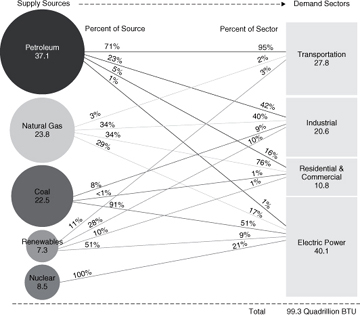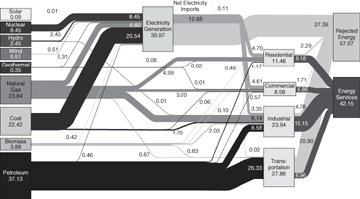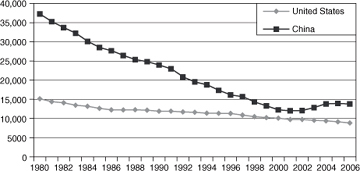1.3. Energy
Energy is required for all economic activity. Inexpensive energy makes possible a high standard of living and many of the conveniences enjoyed in modern societies, such as heating, lighting, electronic devices, travel, and virtually all forms of communications. Therefore, an understanding of global energy supplies, and the environmental impacts associated with energy production and use, is important in understanding our ability to sustain current standards of living.
Energy is often categorized as renewable or nonrenewable. Examples of renewable energy sources include solar radiation, wind, and biomass. Fossil fuels (crude oil, coal, and natural gas) are nonrenewable energy sources because of the long periods necessary for regeneration, which can be on the order of millions of years. As the 21st century begins, the world relies primarily on fossil energy. Petroleum, coal, and natural gas supply 86% of world energy supplies, as shown in Figure 1-1.

Figure 1-1. World energy use in quadrillion (1015) BTU (quads) (EIA, 2009a)
From 1980 until 2006, world energy use increased from just under 300 quadrillion (1015) BTU (quads) to more than 450 quads (an increase of more than 50%). Currently, fossil fuels make up 86% of the world’s energy consumption (EIA, 2009a), while renewable sources such as biomass (including animal waste), hydroelectric, solar, and wind power account for only about 8% of the energy supply. Nuclear energy provides roughly 6% of world energy demand.
Similar energy data for the United States are shown in Figure 1-2. The left-hand side of the figure shows that the distribution of energy sources in the United States is similar to that of worldwide energy sources. Fossil fuels account for 84% of energy use; nuclear and renewables account for roughly equal portions of the remainder. The only significant difference between the U.S. patterns of energy supply and worldwide patterns is the source of biomass-derived fuels. In the United States, ethanol derived from corn was the dominant biomass-derived fuel, whereas worldwide, animal waste used as fuel and ethanol derived from sugarcane were the dominant biomass-derived fuels.

Figure 1-2. Energy sources and uses in the United States, expressed in quads per year; lines connecting energy sources and demand sectors show the percentage of energy sources provided to various demand sectors (left) and the percentage of the demand provided by various sources of energy (right). (EIA, 2009b)
The right-hand side of Figure 1-2 shows the patterns of energy use in the United States, where more than 40% of the energy used is used to generate electricity. The remaining nonelectrical uses are transportation, non-electricity-generating industrial uses, and residential and commercial (largely building) energy use. Lines, with percentages noted at both ends, connect energy sources and energy uses in Figure 1-2. The percentages on the left-hand side of the diagram show the ways in which different fuels are used. The percentages on the right-hand side of the diagram show the types of fuels that are used for different energy applications. The percentages make clear that not all energy sources can be used in all applications. For example, 100% of nuclear power and 91% of coal are used to generate electricity. These fuels are not widely used for other purposes. Transportation relies almost exclusively (95%) on petroleum. Few other fuels are used for this application.
Example 1-1. Per capita energy use
Using the data in Figures 1-1 and 1-2, compare per capita annual energy use in the United States and worldwide. Assume a U.S. population of 300 million and a world population of 7 billion. Convert the result, expressed in BTU per person, into the number of gallons of gasoline that would be required to provide the energy. Assume that the energy content (higher heating value) of gasoline is 124,000 BTU/gal (Argonne National Laboratory, 2011).
Solution: Per capita energy consumption in the United States is more than five times greater than the worldwide average.
U.S. per capita annual energy use = 99.3 * 1015 BTU/300 * 106 people = 330 * 106 BTU/person.
Global per capita annual energy use = 450 * 1015 BTU/7 * 109 people = 64 * 106 BTU/person.
To convert BTU into gallons of gasoline equivalent, assume that the energy content of gasoline is 124,000 BTU/gal.
U.S. per capita annual energy use = 330 * 106 BTU = 2700 gallons of gasoline equivalent per year.
Global per capita annual energy use = 64 * 106 BTU = 520 gallons of gasoline equivalent per year.
Another way to map energy use is shown in Figure 1-3. This mapping, produced by Lawrence Livermore National Laboratory (2010), shows energy sources on the left and energy uses on the right, as in Figure 1-2. Figure 1-3 distinguishes between domestic and imported sources of energy, showing that the primary form of imported energy in the United States is petroleum. In mapping the flow from energy sources to energy uses, Figure 1-3 shows energy losses. These losses come about for a variety of reasons. The largest single category of loss is in electric power generation, amounting to more than a quarter of all U.S. energy use. This loss is in part a result of the laws of thermodynamics, since generating electrical power generally involves converting heat (from burning fuels) into mechanical work (turning a generator with steam made from the heat from burning the fuel). This “waste” heat is not really lost; energy is conserved. Instead, it is simply available at too low a temperature to be of significant economic value in power generation, so it is released into the environment as hot water or hot gases. Example 1-2 illustrates typical energy losses from fuel source to final end use.

Figure 1-3. Mapping of energy sources and uses in the United States for 2008, quantifying energy losses (Lawrence Livermore National Laboratory, 2010)
Example 1-2. Efficiency of energy use
Determine the efficiency of energy utilization for a pump. Assume the following efficiencies in the energy conversion:
- Crude oil to fuel oil is 90% (0.90) (i.e., the energy required to produce and refine crude oil consumes 10% of the energy of the crude oil input to the process).
- Fuel oil to electricity is 40% (0.40) (i.e., the conversion of thermal energy into electrical energy occurs with an efficiency of 40%, roughly the average for the U.S. electrical grid).
- Electricity transmission and distribution is 90% (0.90) (i.e., losses of electricity in transmission from the power plant to the point of use are 10%).
- Conversion of electrical energy into mechanical energy of the fluid being pumped is 40% (i.e., the efficiency of the pump in converting electrical energy into the mechanical energy of the fluid is 40%).
Solution: The overall efficiency for the primary energy source is the product of all of the individual conversion efficiencies.
Overall efficiency = (0.90)(0.40)(0.90)(0.40) = 0.13 or 13%.
As shown in Figure 1-3, more than half of the energy used in the United States is lost in the process of converting the energy into useful forms, such as electricity. As shown in Example 1-2, the losses that occur between the source of the primary energy and the desired outcome of using the energy (such as moving a fluid through a pipe, or delivering horsepower at the wheel of a car, or illuminating a room with a lightbulb; see the problems at the end of the chapter) can be much larger. Improving energy efficiency is the work of engineers, and as shown in Figure 1-4, engineers have continuously improved the energy required per unit of economic output (the T in the IPAT equation) in both developed and developing economies.

Figure 1-4. World energy intensity—total primary energy consumption per dollar of GDP using purchasing power parities (BTU per U.S. dollar (2000)) (EIA, 2009a)
Improving energy efficiency can reduce costs and conserve natural resources. It can also reduce environmental impacts. A variety of environmental impacts are associated with energy consumption. Fossil fuel combustion releases carbon dioxide into the atmosphere. Because of its long residence time in the atmosphere and because it readily absorbs infrared radiation, CO2 can cause global warming. Furthermore, combustion releases oxides of nitrogen and, for some fuels, sulfur into the air, where photochemical reactions can convert them into ground-level ozone and acidrain. Hydropower energygeneration causes landinundation, habitat destruction, and alteration in surface and groundwater flows. Nuclear power has environmental problems linked to uranium mining and spent nuclear fuel disposal. Renewable fuels are not environmentally benign either. Traditional energy usage (wood) has caused widespread deforestation in localized regions of developing countries. Solar power panels require energy-intensive use of heavy metals and creation of metal wastes. Satisfying future energy demands must occur with a full understanding of competing environmental, natural resource, and energy needs.